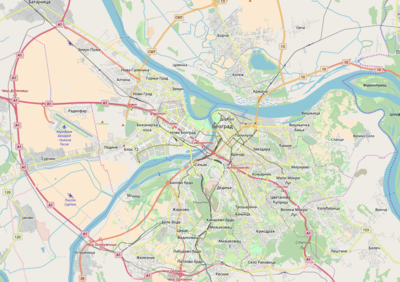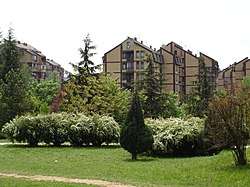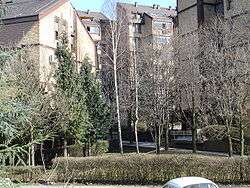Cerak Vinogradi
Cerak Vinogradi (Serbian Cyrillic: Церак Виногради) is an urban neighborhood of Belgrade, the capital of Serbia. It is located in the municipality of Čukarica. Completed by 1988, in January 2019 it became the first modern neighborhood of Belgrade which was declared a cultural monument.[1] It is registered at the Docomomo International and is represented at the permanent exhibition in the New York's Museum of Modern Art.[2]
Cerak Vinogradi Церак Виногради | |
|---|---|
| Etymology: Turkey oak forest and vineyards | |
 Cerak Vinogradi Location within Belgrade | |
| Coordinates: Earth 44°44′N 20°25′E | |
| Country | |
| Region | Belgrade |
| Municipality | Čukarica |
| Area | |
| • Total | 92 ha (227 acres) |
| Population (2002) | |
| • Total | 13,091 |
| • Density | 14,000/km2 (37,000/sq mi) |
| Time zone | UTC+1 (CET) |
| • Summer (DST) | UTC+2 (CEST) |
| Area code | +381(0)11 |
| Car plates | BG |
Location
Cerak Vinogradi is bordered by the neighborhoods of Cerak and Filmski Grad to the north, Rakovica and Skojevsko Naselje to the east, Vidikovac to the south and Ibar Highway to the west. Across the highway are the southern sub-neighborhoods of Žarkovo, Bele Vode and Rupčine. It is divided in two sections, Cerak I and Cerak II. "Pilota Mihajla Petrovića" Street, which divides Cerak Vinogradi and Vidikovac is also a municipality border between Čukarica and Rakovica.[3][4]
History
Initial archeological work discovered a previous settlement at the site, dated to Lower Paleolithic period and Vinča culture.
The area of the present neighborhood was designed in the last years of the 1970s, and is a prime example of late Modern architectural style. The construction began in 1979 and the arrangement of the neighborhood was fully finished in 1988.[5] Once considered one of the most modern and beautiful boroughs of Belgrade, in the 1990s, together with the deteriorating socio-economic conditions of the country, Cerak Vinogradi saw the effect of low maintenance, degradation of the environment, etc.[2]
The settlement was planned for 15,000 inhabitants. There are objects which were part of the project, but were not built: public swimming pool, sports arena, multifunctional center at the corner of the Jablanička Street and the Ibar Highway, etc. One of the neighborhood's architects, Milenija Marušić, stated in 2019 that she will continue to insists that everything is built, as per project.[2]
Characteristics


The borough is residential, with neighborhood type commercial content, and extensive parks and green spaces, with a population of 12,642 in 1991[6] and 13,091 in 2002.[7] Administratively a local community, sub-municipal administrative units since the 1980s, it merged with the neighboring Cerak and Sportski Centar local communities prior to the 2011 census. United Cerak local community had a population of 43,993.[8] As of June 2015 it has three large supermarkets, a medical center, an elementary school and three large kindergartens.
All streets are named after a species of the tree lining the whole length (Ash Street, Linden Street, Cedar Street, etc.). The building type is apartment block, usually paired in a line of G+3 and G+6 floors high. There’s only light traffic (access roads) inside the neighborhood.
The nearby area is residential with developing commercial sector since the 1990s. A shopping mall with a McDonald's restaurant is in the immediate vicinity, with a farmers' market and a number of other stores nearby.
The name itself describes a previous state of the area (Cerak is Serbian for turkey oak forest and Vinogradi is for vineyards).
The neighborhood (including Cerak I and Cerak II, finished in 1987) spreads over an area of 92 ha (230 acres) and has 3,650 residential units in 67 buildings.[1][2]
Assessment
The neighborhood features in the New York's Museum of Modern Art 2018 exhibition exploring the architecture of the former Yugoslavia, Toward a Concrete Utopia: Architecture in Yugoslavia, 1948–1980. The museum researchers preparing the exhibition, stated that Cerak Vinogradi is the only modern neighborhood in former Yugoslavia that hasn't ben ruined by additional construction on the green areas and that ambient unit hasn't been devastated. Due to architectural-urbanistic value, the area was originally under the regime of "full protection", meaning complete preservation of the area, with no changes (possible use changes inside particular objects, with preservation of the authenticity and architectural values of the object) - Criteria K2, K8, K6. On 18 January 2019, Cerak Vinogradi was placed under the state protection and declared a cultural monument, as the first modern neighborhood in Belgrade to be protected.[1] After the Concrete Utopia exhibition was finished, together with New Belgrade's Block 23, Cerak Vinogradi remained represented at museum's permanent collection.[2]
After previous bad experience with Blocks 61, 62 and 63, where they had to work under the dictate of the urbanists, here the Marušićs worked together with the chief urbanist in the project, Dragutin Kadović. They followed the rules set by the Roman architect Vitruvius in the 1st century: architecture depends on order, layout, euryhtmics, symmetry and economy. The resulting architecture of Cerak Vinogradi is "stylishly clear, inconspicuous, economically rational and proportional to the people of all generations, offering the sense of harmony, simplicity and warmth".[5]
The neighborhood remains one of the last integrally planned urban units in Belgrade and the superior achievements in the entire Yugoslav architecture.[2] Authors (Milenija and Darko Marušić and Nedeljko Borovnica) won The October prize (Оktobarska nagrada) for the Cerak Vinogradi project in 1985.
Transportation
Cerak Vinogradi is a few minutes away from the park-forest of Košutnjak, a short bus ride from major commercial center of Banovo Brdo, river Sava and the island and lake of Ada Ciganlija. It is also well connected with the rest of the city by public bus (GSP Belgrade) lines 23, 37, 50, 51, 52, 53, 56, 59, 89, 531, 532, 533 and 534.
References
- Daliborka Mučibabić (31 January 2019). "Prvo moderno stambeno naselje postalo kulturno dobro" [First modern residential neighborhood declared a cultural monument]. Politika (in Serbian). p. 14.
- Daliborka Mučibabić (28 August 2019). Блок 23 и Церак виногради у сталној колекцији музеја МоМА [Block 23 and Cerak VInogradi in permanent collection of the MoMA]. Politika (in Serbian). p. 16.
- Tamara Marinković-Radošević (2007). Beograd - plan i vodič. Belgrade: Geokarta. ISBN 978-86-459-0297-2.
- Beograd - plan grada. Smedrevska Palanka: M@gic M@p. 2006. ISBN 86-83501-53-1.
- Borislav Stojkov (23 February 2019). "Марушићи, урбанисти са штофом" [The Marušićs, urbanists with a gift]. Politika-Kulturni dodatak, year LXII, No. 46 (in Serbian). p. 7.
- Stanovništvo prema migracionim obeležjima – SFRJ, SR i SAP, opštine i mesne zajednice 31.03.1991, tabela 018. Savezni zavod za statistiku (txt file).
- Popis stanovništva po mesnim zajednicama, Saopštenje 40/2002, page 4. Zavod za informatiku i statistiku grada Beograda. 26 July 2002.
- Stanovništvo po opštinama i mesnim zajednicama, Popis 2011. Grad Beograd – Sektor statistike (xls file). 23 April 2015.
External links
| Wikimedia Commons has media related to Cerak Vinogradi. |